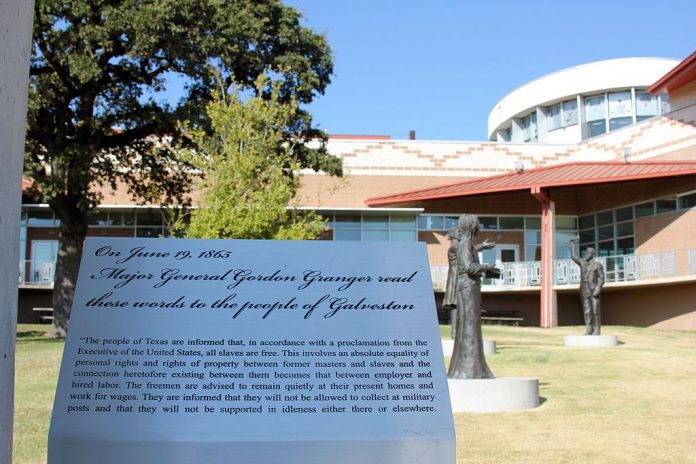Juneteenth or June 19th is a holiday that is currently becoming rapidly popularized. On June 19th, 1865, Union soldiers landed in Galveston, Texas to enforce the Emancipation Proclamation that freed slaves in America. This was two and a half years after President Lincoln issued the Emancipation Proclamation, January 1, 1863. There is a concerted effort to make this a national holiday to celebrate the end of slavery.
The Emancipation Proclamation had little effect at the time since the majority of slaves were held in states that were part of the confederacy and did not recognize the authority of the United States government. Many more slaves were freed after the surrender of General Lee on April 9, 1865, at Appomattox Court House, VA.
Major General Gordon Granger read the order to the citizens of Galveston:
“The people of Texas are informed that, in accordance with a proclamation from the Executive of the United States, all slaves are free. This involves an absolute equality of personal rights and rights of property between former masters and slaves, and the connection heretofore existing between them becomes that between employer and hired labor. The freedmen are advised to remain quietly at their present homes and work for wages. They are informed that they will not be allowed to collect at military posts and that they will not be supported in idleness either there or elsewhere.”
According to the Texas State Library,
“Large celebrations on June 19 began in 1866 and continued regularly into the early 20th century. African-Americans treated this day like the Fourth of July, and the celebrations contained similar events. In the early days, Juneteenth celebrations included a prayer service, speakers with inspirational messages, reading of the Emancipation Proclamation, stories from former slaves, food, red soda water, games, rodeos and dances.
“The celebration of June 19 as Emancipation Day spread from Texas to the neighboring states of Louisiana, Arkansas and Oklahoma. It also appeared in Alabama, Florida and California as African-American Texans migrated.
“Celebration of Juneteenth declined during World War II but returned in 1950 Texas State Fair Grounds in Dallas. Interest and participation fell away during the late 1950s and 1960s as attention focused on expansion of freedom for African-Americans. In the 1970s Juneteenth revived in some communities. For example, in Austin the Juneteenth celebration returned in 1976 after a 25-year hiatus. Texas House Bill 1016 passed in the 66th Legislature, Regular Session, declared June 19, “Emancipation Day in Texas,” a legal state holiday effective starting in 1980. Since that time, the celebration of Juneteenth continues across the state of Texas with parades, picnics and dancing.”
There are many other dates that are important in the ending of slavery as an institution. Below are a few.
On April 16, 1862 slavery was abolished in Washington D.C.
On September 22, 1862, Lincoln issued the preliminary Emancipation Proclamation Order
On January 1, 1963, the Emancipation Proclamation became law
On January 31, 1865, Congress passed the 13th Amendment abolishing the institution of slavery
On April 3, 1865, Richmond, Va., the capital of the Confederacy was captured
On April 9, 1865, General Lee surrendered to General Ulysses Grant at Appomattox, Va.
On December 6, 1865, the 13th Amendment was ratified

